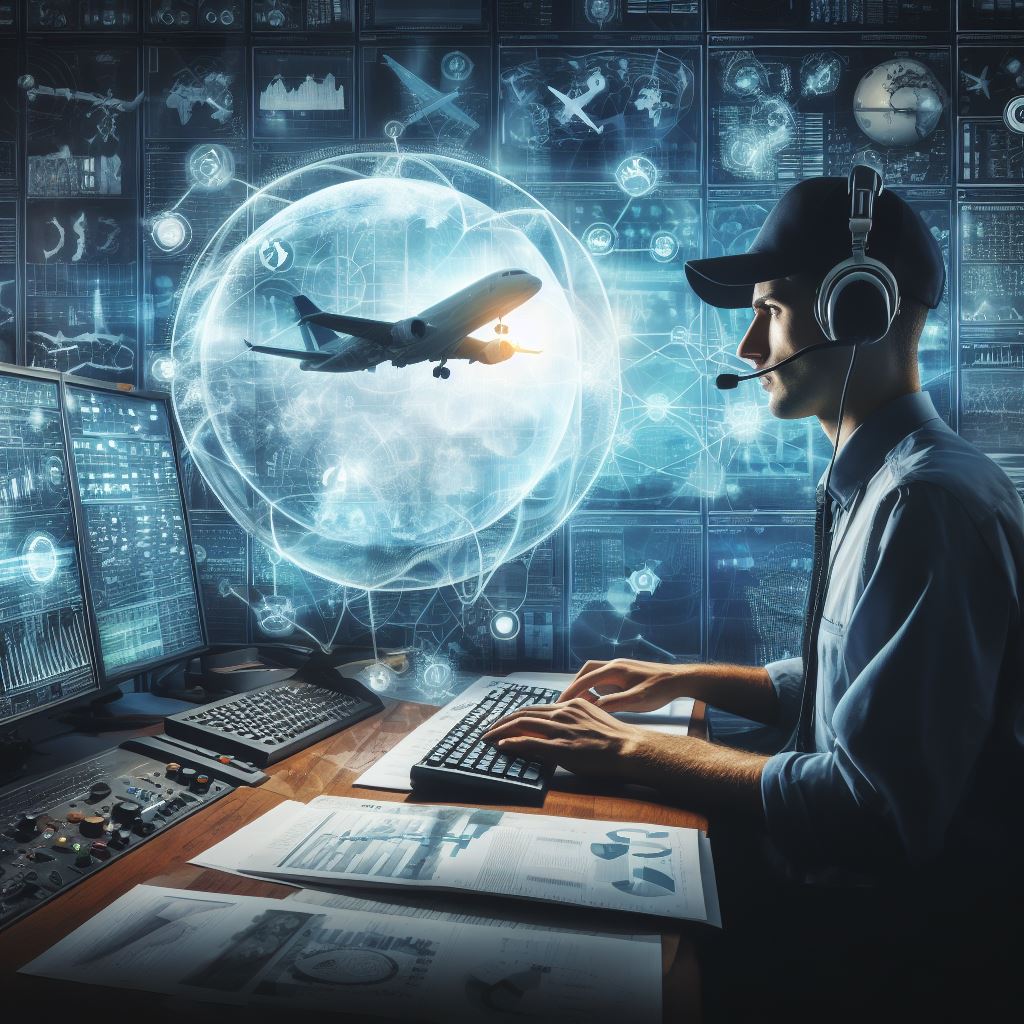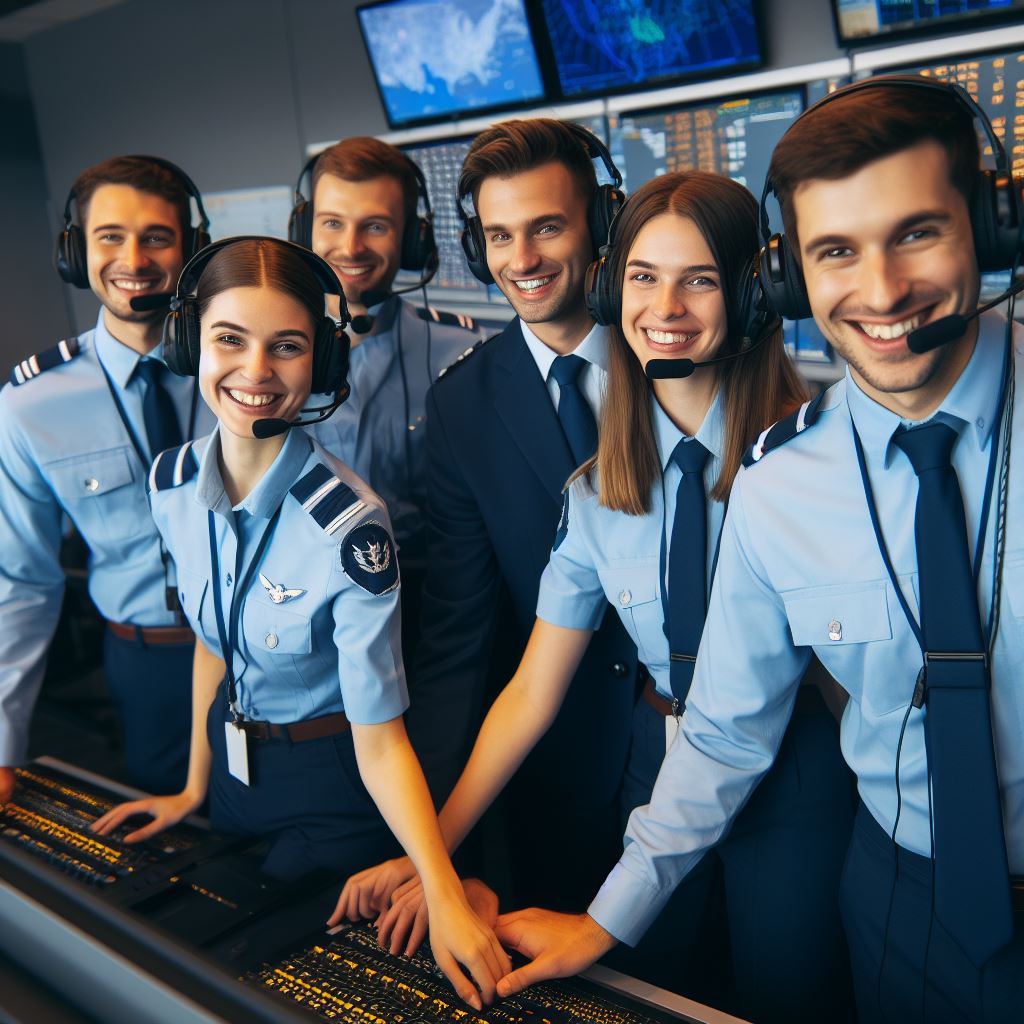Introduction
Air traffic control (ATC) is responsible for managing the safe movement of aircraft in the USA.
Air Traffic Control (ATC) guides aircraft, ensuring safe takeoffs, landings, and in-flight paths. Controllers manage airspace, preventing collisions and ensuring efficient traffic flow.
They communicate vital instructions to pilots, maintaining order in the skies.
Utilizing radar and communication tools, ATC personnel monitor aircraft movements, providing real-time guidance.
ATC is a critical component of aviation safety, orchestrating the complex dance of planes in the sky.
These professionals undergo rigorous training to handle diverse situations, from adverse weather conditions to emergencies.
The precision and quick decision-making of ATC contribute significantly to the seamless functioning of the global aviation network, safeguarding the lives of passengers and crew.
Technology plays a crucial role in enhancing the efficiency and effectiveness of ATC operations.
Technology revolutionizes Air Traffic Control (ATC), enhancing safety and efficiency. Advanced radar systems precisely monitor aircraft.
Automated communication tools streamline coordination, ensuring swift responses.
Real-time data analytics enable proactive decision-making, optimizing airspace utilization.
Cutting-edge software aids controllers in managing diverse traffic scenarios seamlessly.
Integration of artificial intelligence bolsters predictive capabilities, mitigating potential risks.
Continuous advancements in technology empower ATC professionals to adapt to evolving airspace demands, safeguarding global aviation.
Thesis statement: The impact of technology on air traffic control in the USA has been significant and transformative.
Historical Overview of Air Traffic Control
Evolution of ATC from the early days
- Air Traffic Control (ATC) has come a long way since its humble beginnings.
- In the early days of aviation, there were no formal systems in place to manage air traffic.
- Pilots navigated using landmarks and communicated with each other using basic radio technology.
- As air travel became more popular, the need for a centralized control system became evident.
- The first ATC tower was established in Cleveland, Ohio, in 1930, introducing the concept of organized air traffic control.
- This early system relied on visual observation and communication to manage air traffic.
Introduction of radar technology and its impact
- One of the most significant advancements in ATC came with the introduction of radar technology.
- Radar allows controllers to track the precise location of aircraft in real-time.
- This innovation greatly improved the safety and efficiency of air traffic management.
- Radar systems were first introduced in the 1950s and quickly became an integral part of ATC operations.
- Controllers could now monitor multiple aircraft simultaneously, providing better situational awareness.
- Radar facilitated the introduction of controlled airspaces and precise separation between aircraft.
Adoption of computer systems in ATC
- In the late 20th century, computer systems began to revolutionize air traffic control.
- These systems automated many manual tasks, reducing the likelihood of human errors.
- Automation also allowed for more efficient routing and improved air traffic flow management.
- Computerized display screens replaced traditional paper flight strips, providing better data visualization.
- New technologies, such as the En Route Automation Modernization (ERAM) system, further enhanced ATC capabilities.
- ERAM, implemented in the early 2010s, introduced a centralized system to handle en-route air traffic control.
Overall, the evolution of air traffic control from its early days to the present has been driven by technological advancements.
The introduction of radar technology allowed for more precise tracking and improved safety measures.
Additionally, the adoption of computer systems automated many tasks, leading to increased efficiency and better air traffic management.
As technology continues to advance, the future of air traffic control in the USA holds the promise of further enhancing safety, reducing delays, and accommodating the growing demand for air travel.
Current State of Air Traffic Control Technology
Description of the modern ATC equipment and systems
- Air Traffic Control (ATC) in the USA has evolved significantly due to advancements in technology.
- Modern ATC equipment and systems are now used to manage and monitor air traffic.
- These systems include radar, automation, digital displays, and satellite communication and navigation.
Overview of radar systems and their capabilities
- Radar systems play a crucial role in air traffic control by tracking the position of aircraft.
- They use radio waves to detect and locate aircraft in real-time.
- Radar systems can provide important data such as altitude, speed, and direction of aircraft.
- This information is used by air traffic controllers to ensure safe and efficient flights.
Introduction of automation and digital displays
- Automation has greatly improved the efficiency of air traffic control operations.
- Computer systems now automate tasks like flight planning and data processing.
- Digital displays show real-time information about flights, helping controllers make informed decisions.
- Automation and digital displays have significantly reduced human errors in air traffic control.
Implementation of satellite communication and navigation systems
- Satellite communication and navigation systems have revolutionized air traffic control.
- These systems enable more precise tracking of aircraft, leading to improved safety.
- Satellite communication allows controllers to maintain constant communication with pilots.
- Navigation systems based on satellites provide accurate positioning information for aircraft.
Essentially, the current state of air traffic control technology in the USA is highly advanced.
Transform Your Career Today
Unlock a personalized career strategy that drives real results. Get tailored advice and a roadmap designed just for you.
Start NowModern ATC equipment and systems, including radar, automation, digital displays, and satellite communication and navigation, have greatly improved the efficiency and safety of air traffic control operations.
Radar systems track aircraft in real-time, automation and digital displays automate tasks and provide real-time information, while satellite communication and navigation systems enable precise tracking and accurate positioning.
With continued advancements in technology, the future of air traffic control in the USA looks promising.
Read: Transitioning from a Pilot to a Flight Instructor Role
Benefits of Technology in Air Traffic Control
Air traffic control (ATC) is a crucial element in ensuring the safety and efficiency of the aviation industry.
Over the years, advancements in technology have revolutionized ATC systems, providing numerous benefits.
In this section, we will explore the advantages brought about by technology in air traffic control in the USA.
Enhanced Safety Measures through Advanced Surveillance and Tracking
- Implementation of radar and satellite-based surveillance systems enables accurate and real-time tracking of aircraft.
- Improved situational awareness allows controllers to identify potential conflicts and take proactive measures.
- Technologies like Automatic Dependent Surveillance-Broadcast (ADS-B) enhance aircraft visibility, reducing the risk of mid-air collisions.
- Integration of ground and airborne surveillance systems enhances safety during takeoff, landing, and taxiing.
Increased Efficiency and Capacity for Handling Air Traffic
- Advanced automation and data processing capabilities enable faster and more accurate flight planning and routing.
- Dynamic algorithms optimize routes, reducing congestion and delays in busy airspace.
- Technology enables controllers to handle more flights simultaneously, increasing airspace capacity.
- Efficient use of airspace and runways leads to fuel savings and reduced environmental impact.
Streamlined Communication between ATC Personnel and Pilots
- Modern communication systems like data link technology facilitate direct and clear communication between controllers and pilots.
- Elimination of voice-only communications reduces the chance of misunderstandings and improves operational efficiency.
- Text-based messaging systems enable non-urgent communications, reducing radio congestion.
- Improved communication enhances collaborative decision-making and coordination between ATC and pilots.
Improved Weather Monitoring and Storm Avoidance Capabilities
- Highly advanced weather radar systems provide accurate and timely information to controllers and pilots.
- Real-time weather updates enable proactive rerouting, avoiding turbulent areas and hazardous weather conditions.
- Improved weather monitoring minimizes the disruption caused by major weather events, reducing delays.
- Access to accurate meteorological data enhances flight safety and improves overall operational efficiency.
In essence, the impact of technology on air traffic control in the USA has brought about numerous benefits.
Enhanced safety measures through advanced surveillance and tracking, increased efficiency and capacity for handling air traffic, streamlined communication between ATC personnel and pilots.
And improved weather monitoring and storm avoidance capabilities are some of the advantages technology has provided.
These advancements have not only improved the safety and efficiency of air traffic control but also contributed to the overall growth and development of the aviation industry.
Read: Veteran Pilots Share Their Most Memorable Flights

Challenges and Issues in Implementing Technology in ATC
Air Traffic Control (ATC) plays a crucial role in ensuring the safe and efficient operation of the aviation industry.
With the rapid advancement of technology, various challenges and issues arise when implementing new technology in ATC systems.
Reliability and Maintenance Concerns
- One of the primary challenges is ensuring the reliability of technology in ATC.
- The system should be robust enough to handle high volumes of air traffic without any glitches.
- Regular maintenance and updates are necessary to minimize the chances of equipment failure.
- Any downtime could result in disruptions to flights and potential safety risks.
- Effective maintenance programs must be in place to address these concerns.
Potential Cybersecurity Threats and Vulnerabilities
- The reliance on technology exposes ATC systems to potential cybersecurity threats.
- Hackers may target the systems in order to disrupt air traffic or gain unauthorized access.
- Vulnerabilities in software and hardware can be exploited for malicious purposes.
- Implementing strong cybersecurity measures is crucial to safeguard the integrity of ATC systems.
- Regular security audits and updates should be conducted to address emerging threats.
Training and Adaptation for ATC Personnel
- Introducing new technology requires extensive training for ATC personnel.
- They need to be familiar with the features, functions, and limitations of the new systems.
- The transition period can be challenging as controllers adapt to the new tools.
- Efficient training programs should be implemented to ensure a smooth integration of technology.
- Ongoing support and continuous training are vital for ATC personnel to stay updated.
Balancing Automation with Human Decision-Making
- The use of technology in ATC raises questions about the balance between automation and human decision-making.
- Automation can improve efficiency, but it may also lead to overreliance on machines.
- Human controllers play a critical role in analyzing complex situations and making critical decisions.
- Proper guidelines and protocols should be established to determine when human intervention is necessary.
- Striking the right balance between automation and human decision-making is pivotal in ATC systems.
In general, the implementation of technology in ATC systems poses several challenges and issues.
Ensuring reliability and proper maintenance, addressing cybersecurity threats, providing effective training programs, and balancing automation with human decision-making are crucial elements in the successful integration of technology into the air traffic control industry.
By addressing these challenges, the aviation industry can continue to benefit from technological advancements while maintaining a high level of safety and efficiency.
Read: How Technology is Changing the Future of Flying in the US
Future of Air Traffic Control Technology
Emerging technologies in ATC, such as AI and machine learning
The field of air traffic control is constantly evolving, driven by the emergence of new technologies. One such technology is artificial intelligence (AI) and machine learning.
Showcase Your Business Today
Reach thousands of readers actively exploring professional services. Publish your business profile and grow your audience now.
Publish NowThese technologies have the potential to revolutionize how air traffic control is conducted.
AI can assist air traffic controllers in optimizing flight routes and predicting potential issues, allowing for more efficient and safe operations.
Machine learning algorithms can analyze large amounts of data to identify patterns and trends, helping controllers make informed decisions.
Potential for fully automated ATC systems
With advancements in technology, the possibility of fully automated air traffic control (ATC) systems is becoming more realistic.
These systems would rely on AI, machine learning, and other advanced technologies to perform the functions currently handled by human controllers.
Fully automated ATC systems would offer numerous benefits, including increased efficiency, reduced human error, and improved accuracy in monitoring and managing air traffic.
However, there are also concerns regarding the reliability and safety of such systems, which would need to be addressed before widespread implementation.
Integration of unmanned aircraft systems (UAS) into ATC
Unmanned aircraft systems (UAS), commonly known as drones, are becoming popular in various industries, including aviation.
As UAS usage increases, there is a need to integrate them into existing air traffic control systems.
This integration poses several challenges, such as developing regulations and procedures for UAS operations, ensuring the safe and efficient integration of manned and unmanned aircraft, and managing the increased complexity of airspace.
However, with the right technology and regulations, UAS can enhance ATC capabilities and enable new applications.
Continued research and development in the field
The future of air traffic control technology relies heavily on continued research and development.
As new technologies emerge and evolve, it is necessary to invest in research to understand their potential applications and limitations.
Ongoing research can lead to advancements in communication systems, data analytics, automation, and other crucial areas.
It can also help address the challenges associated with integrating new technologies and ensure that ATC systems remain safe, efficient, and reliable.
Read: A Day in the Life of a US-based Airline Pilot
Conclusion
Recap of the impact of technology on air traffic control in the USA
Over the years, technology has revolutionized air traffic control in the USA.
Advanced radar systems, computerized communication networks, and automation have significantly improved the efficiency and safety of air travel.
Real-time data analysis and predictive algorithms have streamlined decision-making processes, ensuring accurate and timely traffic management.
Acknowledgment of the ongoing advancements and challenges
While technology has brought immense benefits to air traffic control, it is crucial to acknowledge that advancements continue to shape the industry.
Ongoing research and development aim to create even more advanced systems, including artificial intelligence and unmanned aircraft management.
Additionally, addressing cybersecurity concerns and integrating new technologies seamlessly pose ongoing challenges.
Closing thoughts on the importance of technology in ensuring efficient and safe air travel
Technology plays a fundamental role in ensuring the efficient and safe operation of air traffic control in the USA.
It enables controllers to handle increasing air traffic volume, optimize routes, and minimize delays.
Moreover, it enhances situational awareness, facilitates communication between air traffic control and pilots, and helps prevent collisions and accidents.
Embracing and investing in technological advancements will be critical to meet future demands and maintain a high level of air travel safety.
[E-Books for Sale]
The Big Book of 500 High-Paying Jobs in America: Unlock Your Earning Potential
$19.99 • 500 High-Paying Jobs • 330 pages
Explore 500 high-paying jobs in America and learn how to boost your career, earn more, and achieve success!
See All 500 High-Paying Jobs of this E-Book
1001 Professions Without a Degree: High-Paying American Jobs You Can Start Now
$19.99 • 1001 Professions Without a Degree • 174 pages
Discover 1001 high-paying jobs without a degree! Unlock career tips, skills, and success strategies for just $19.99!




